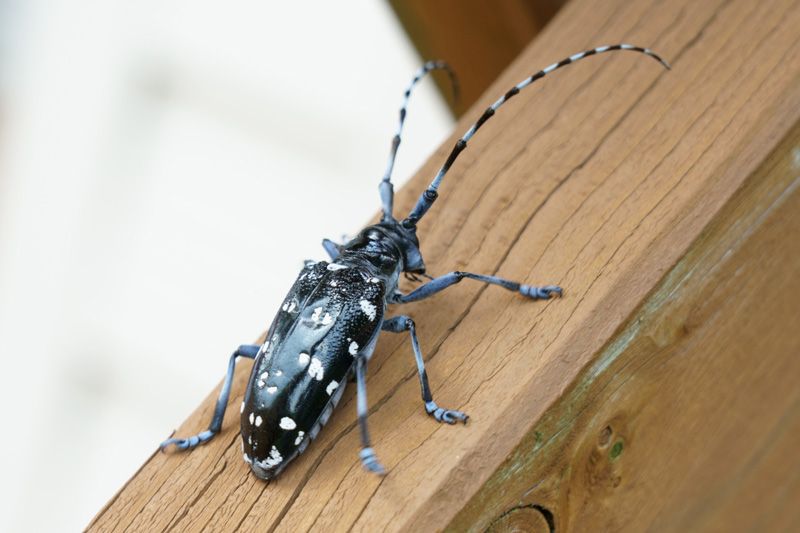
Asian Longhorned Beetle – Anolplohora glabripennis
Asian Longhorned Beetle – Anolplohora glabripennis
Description of Insect:
The Asian longhorned beetle (Anoplophora glabripennis), also known as the starry sky, or ALB, is a wood-boring insect native to China and Korean Peninsula. Adult beetles are large and striking in appearance, typically measuring 27-39 mm in length.
They have a glossy black body adorned with irregular white 20 white spots on each wing. The long, segmented antennae are twice the size of their body length and are distinctively banded in black and white.
Larvae are pale and elongated, measuring up to 50 mm when fully grown. They burrow deep into the heartwood of trees, causing extensive damage. The larvae go through 7 to 8 instars, consuming 1,000 cubic cm of wood throughout its life.
Life cycle of Asian Longhorned Beetle
The life cycle of the Asian longhorned beetle includes egg, larva, pupa, and adult stages. Female beetles chew small depressions into the bark of host trees to lay their eggs, typically depositing 100 eggs in their lifetime. Eggs hatch within two to three weeks, and the larvae immediately begin feeding on the cambium layer beneath the bark.
As larvae grow, they tunnel deeper into the wood, creating galleries that disrupt the tree’s vascular system. The larvae overwinter in the tree, followed by pupation in Spring, during which the insect transforms into an adult.
Adult beetle chews its way out of the tree, leaving a characteristic round exit hole approximately 15-20 mm in diameter. The entire life cycle can take one to two years in warmer regions, and 3 to four years in cooler regions.
Damage they cause:
The Asian longhorned beetle is one of the most destructive invasive pests due to its impact on forests, urban landscapes, and economic resources.
- Ecological Impact: ALB infestations have a devastating effect on forest ecosystems. The beetles target a wide range of hardwood tree species, especially maple trees, reducing biodiversity and disrupting natural habitats. In addition, infested trees also pose a safety risk, as they are more likely to fall during storms.
- Urban Damage: In urban and suburban areas, ALB poses a significant threat to street trees and ornamental plants. Infested trees often die within a few years, leading to increased costs for removal and replacement. It kills shade and park trees, dramatically altering the appearance and ecological value of parks, gardens, and cityscapes.
- Economic Impact: The economic consequences of Asian longhorned beetle infestations are enormous. The cost of managing infestations, removing trees, and implementing control measures; especially for street trees places a heavy burden on municipal budgets. A total value loss of more than $669 billion would occur if ALB spread to all urban areas of the lower 48 states. Furthermore, if the infestation spreads to a forest ecosystem, it could harm the export market of hardwood products like veneers.
